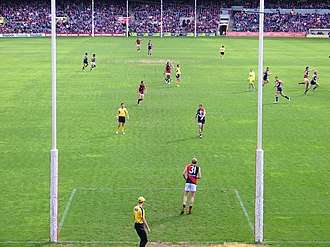Kick-in
In the sport of Australian rules football, a kick-in (sometimes known as a kick-out) is the formula to restart the game after a behind. Thus, it occurs when an opposition team scores a behind, with a defender kicking the ball out from the defensive goalsquare. The team kicking in may elect any one of its players to take the kick-in. The man on the mark stands five metres in front of the goal square. The player kicking in is given approximately ten to fifteen seconds from when they pick up the ball to take their kick before the umpire will call play-on, at which point the man on the mark may advance. Players kicking in may either kick to a teammate, or kick to themselves to allow themselves to play on. Whichever option is taken, the player must kick from wholly within the white lines of the goal square, even if the umpire has already called play-on for taking too much time - if their foot touches the line of the goal square, then play is stopped and the umpire will bounce the ball at the centre of the kick-off line.

If a kick-in goes out of bounds without being touched by another player, the boundary umpire will signal out on the full and award a free kick to the opposition, whether or not the ball has bounced before going out. This is to prevent teams from getting their longest kicker to kick for touch. Kicking to oneself satisfies the kick-in condition, so any further kick taken will be treated normally.
Historically, kick-in strategy would be that the team's longest kicker would send the ball as far down the field as possible, resulting in a marking contest; this way, even if an opponent took a contested mark, they would be one long kick plus ten metres away from the goal line, and would be hence unlikely to score. The 1970s saw the birth of the huddle, which pioneered the act of pinpointing a shorter pass to a teammate.
In the modern game a quick kick-in exists when a behind is scored in a largely vacant forward-line; the rule change (see below) means that the opposition cannot man up, and the first couple of kicks generally come very easily. For non-quick kick-ins, huddles are sometimes used, which require man coverage. Otherwise, zone coverage is most common. Some teams will set their players up 25-50m out from goal, and these teams aim to take a couple of safe short passes to progress 30m down the field, at which stage the field is wider and the downfield options are more free. Other teams set up a longer kick-in, leaving the first 30m largely vacant. Teams who do this will seek to find a 40-50m pass on the lead; if no leads are available, then the player will kick to himself and begin to run into the empty space, forcing the downfield options into a wider area and potentially an easier pass.
Rule changes
In the 2005 Australian Football League (AFL) season, a player who kicked to themselves from the kick-in was allowed to do so by a simple tap-kick (kicking the ball clear of hand and foot). Prior to this season, the kick must have begun behind the white line, and ended over it; this was deemed to be an irrelevant technicality, and was accordingly removed. In 2006, new rule changes meant that a player did not have to wait for the Goal Umpire's flags to be waved before kicking out, and could kick out as soon as a behind was signalled. This sped up the flow of the game significantly but angered some.
Nine rule changes were announced for the 2019 AFL season, including changes to the kick-in. The new rules meant players no longer needed to kick to themselves to play on from a kick-in, and the man on the mark was required to stand ten metres from the top of the goal square, adjusted from five. Steve Hocking, the AFL's football operations manager, believed the change would promote an "exciting" strategy.[1]
References
- Ryan, Peter (11 October 2018). "Kick-in rules to change as 18-metre goal square idea discarded". The Age. Fairfax Media. Retrieved 21 January 2019.